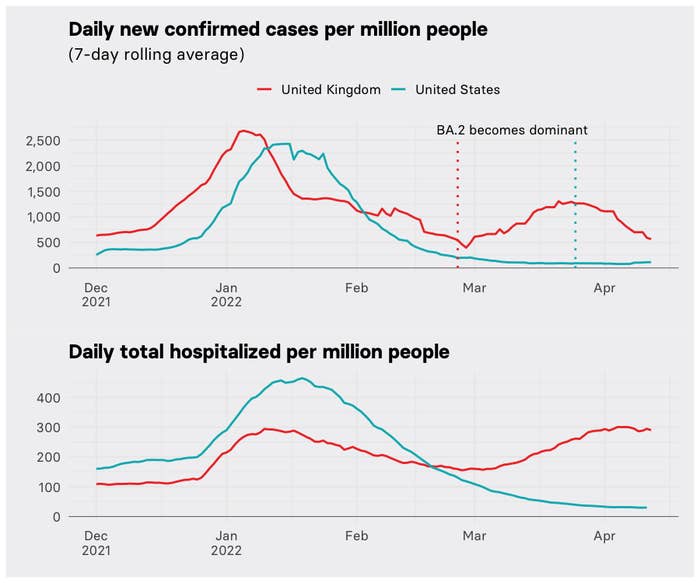We Might Be Looking At COVID “Seasons” For Years To Come
“I know everybody wants great news, that we can be done with COVID and everything’s gonna be fine, but that’s not really true.”
The latest high-profile poster child for a COVID superspreader event was the playdate of the powerful — the storied Gridiron dinner in Washington, DC, that infected New York’s mayor, the US attorney general, and at least 70 others this month.
That outbreak points to the end of a long-sought lull in the deadly pandemic that has officially killed nearly 1 million Americans. Just how big a change it will herald, though, is hard to gauge.
“It’s really tough to say what is going to happen,” Anthony Fauci, President Joe Biden’s chief pandemic scientist, told BuzzFeed News. Virtually everyone across the country has some immunity to COVID from shots or infections, or both. “But there are going to be new variant

Peter Aldhous / BuzzFeed News / Via Our World In Data / outbreak.info / Via outbreak.info
After the first Omicron wave, the UK has experienced a second rise in COVID-19 driven by the BA.2 variant. So far, the US has not. (Dates given for dominance of BA.2 are when the seven-day rolling average for the variant’s frequency reached 50% of all samples genetically sequenced.)
Despite the easing of mask guidelines and 95% of counties reporting “low” community risk rates, there are signs of another potential wave of COVID, with upticks in cases in New York and Washington, DC — homes to the Gridiron crowd. In the United Kingdom — the harbinger of past US surges — climbing cases from the BA.2 form of the Omicron variant last month reversed a similar lull there, with hospitalizations rising to levels seen during the first Omicron surge. One in 13 people in England was thought to be infected in the first week of April, according to the UK’s Office for National Statistics.
Twitter: @EricTopol
Only in the last three weeks, BA.2 has become the dominant variant in the US, now accounting for 86% of cases, according to the CDC. In that same time, US cases have hovered at around 28,000 new reports daily, a plateau in numbers that hasn’t been seen since last June. And daily hospitalizations, perhaps the most telling pandemic indicator, are down to around 1,400 a day in the US, less than a tenth of the rate at the height of January's Omicron spike. Still, there are cases rising in the Northeast, so much so that Philadelphia reinstituted its mask mandate on Monday.
“It does seem like what’s happening on the East Coast is nearing what has happened in Europe and in the UK, where BA.2 really did kind of pick up,” University of Arizona evolutionary biologist Michael Worobey said. “The good thing is that hospitalizations and deaths are not increasing nearly as much as with prior surges.” That break from the past, he added, could mark a turning point in the pandemic.
ADVERTISEMENT
About 77% of the US population now has at least one vaccine shot, and more than 43% of the population is thought to have been infected at least once by the coronavirus, or SARS-CoV-2, providing some immunity. Add in warmer spring weather, curbing a virus that more easily spreads indoors, and crystal balls look hazy for April, although many observers expect at least some sort of COVID surge. Just how much is unclear.
“The more immunity we have in a population, and especially the more immunity we have to variants that are related to the thing that’s currently circulating, the less chance that I see of a major surge,” said Stephen Kissler of Harvard’s T.H. Chan School of Public Health.
While surges have come in the late summer and late winter in the US, he added, “early spring is sort of the time when we’ve seen the lower cases.”
Another question is how much immunity to BA.2 does past infection with the original Omicron BA.1 variant “sublineage” provide? BA.1 was only detected in November in South Africa before it rocketed around the world, causing tremendous surges. Omicron’s pronounced genetic differences from past variants — notably dozens of mutations on the spike protein it uses to first invade cells — let the virus evade treatment and vaccine defenses far more easily. BA.2’s mutations overlap to a large extent with BA.1, and a preliminary study released from Denmark suggests infection with the latter provides good “ cross-reactive” protection against the former.
But even the experts disagree on what comes after BA.2. Some expect a split bump in cases, like University of Chicago infectious disease expert Emily Landon.
“I actually doubt that BA.2 is going to cause a major problem up in the northern half of the country, but it has a real potential to cause a surge in the South over the summer,” Landon said.
“I think there’s every reason to believe that that might happen and so, getting ahead of that, I certainly think anyone who wants to be protected should do that,” she added, referencing a second booster shot for those who are eligible.
Twitter: @DFisman |




